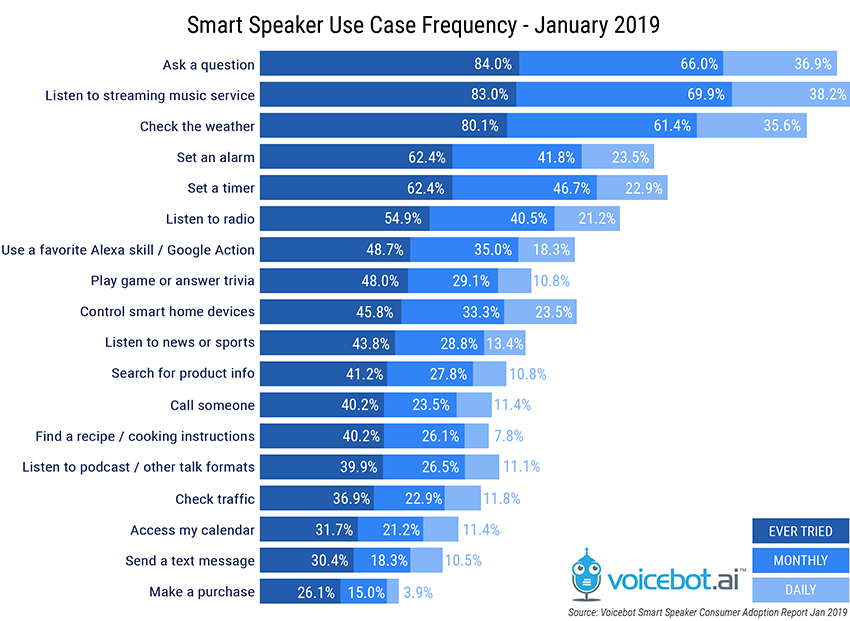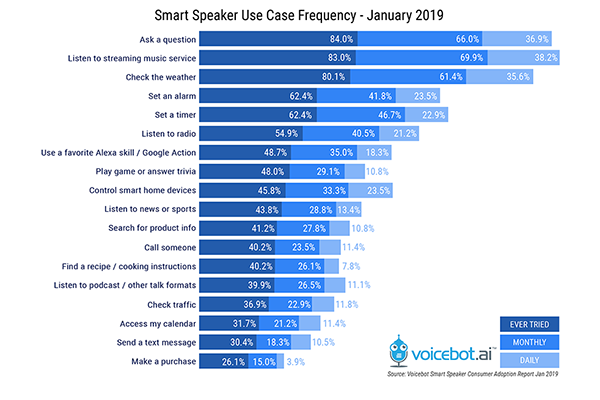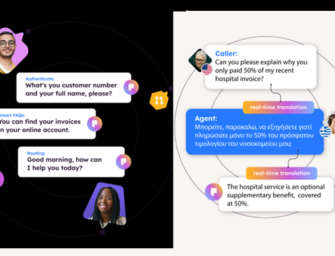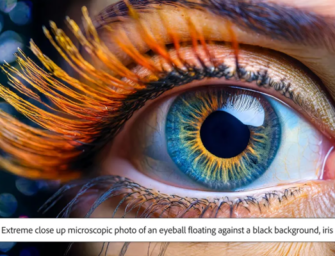Smart Speaker Owners Agree That Questions, Music, and Weather are Killer Apps. What Comes Next?
How do consumers use smart speakers? There are many surveys that ask smart speaker owners what they have tried and even one that asked what use case device owners find most valuable. However, Voicebot has the only research on how frequently consumers use various smart speaker use cases. In the 2019 Smart Speaker Consumer Adoption Report developed in collaboration with Voicify, consumers reaffirmed their actual use of smart speakers for answering questions, listening to music, and asking about the weather.
These were the top three reported use cases among U.S. smart speakers owners in terms of “every tried” as well as on a monthly and daily basis. It may not be surprising that these use cases were each tried by over 80% of smart speaker owners, but two-thirds are asking questions and calling up a streaming music service monthly while nearly 40% are doing so daily. This is a robust usage profile for these devices.

The Killer App for Voice will Vary by Surface
Many people have suggested that voice really needs a killer app to succeed. The premise behind that sentiment is flawed because it assumes voice is one thing. Voice assistants can help with a wide variety of use cases and be used across multiple device surfaces. What we are likely to see is a series of killer apps some of which may be localized to a particular surface. For example, voice interactive navigation may be a killer app for the car, but only a minor benefit for smart speakers and inconsistently used on mobile. You can learn more about voice assistant use on other surfaces in the Voice Assistant Consumer Adoption Report from late 2018 and the In-Car Voice Assistant Consumer Adoption Report from 2019.
Smart speaker adoption is so strong because it already has a killer app trio with listening to music as the foundation. There is little doubt that convenience for getting weather information and answers to questions is valued by consumers. You can see it clearly in their behavior. However, it is unclear whether these features alone have driven smart speaker adoption. Music listening is different because it fills a voice left by the disappearance of radios and stereo systems in many households. And, music listening through streaming services and the radio are both among the top six smart speaker use cases. Far-field voice recognition paired with music and other audio services are an ideal match of form and function.
Expanding Use Cases Beyond the Top 3
The top use cases for smart speakers are clustered around information, alerts, and entertainment. Interesting, utilities such as smart home control, phone calls, and messaging are well down the popularity list which is in many ways opposite of how consumers are using voice assistants today on smartphones and more evidence of usage profiles differing by device. However, a more interesting use case to consider is employing third-party Alexa skills and Google Actions. Fewer than half of consumers say they have tried these third-party voice apps. Alex Dunn, Principal Architect, Voicify
What we see with the top use cases is society finding immediate utility with existing and popular functionality. As brands begin to leverage the support and problem-solving nature of conversation, we should expect the use cases to become more varied and complex.
This contention makes sense. Third-party voice apps have a discovery problem more than a usage problem. Whereas only about 49% of users say they have tried third-party voice apps, 35% have become monthly active users. That is a 72% conversion rate to monthly use. This doesn’t mean all third-party voice apps have this conversion rate. Voicebot estimates smart speaker owners that try third-party voice apps check out an average of 2.7 different Alexa skills or Google Actions. This still appears to yield an impressive 26% trial to monthly use conversion rate. As overall trial rates increase among smart speaker owners and the number of third-party voice apps evaluated rises, this conversion rate is sure to fall. However, that may be a good thing as it will indicate better discovery and a recognition that not every voice app tried will become part of a consumers’ daily routine.
What we can see for certain in the data that beyond the top three use cases, consumers are employing smart speakers for a wide variety of use cases. It may be that most users will have five top use cases with the first three being common and the latter two being unique to their daily needs. You can learn more about smart speaker use case and other characteristics of device adoption by downloading the 2019 U.S. Smart Speaker Consumer Adoption report below.
Download Now
Follow @bretkinsella Follow @voicebotai
Better Business Conversations Start with Third-Party Voice Apps, But First-Party Rules Today









